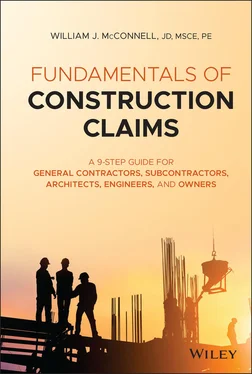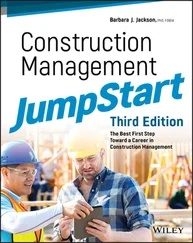2. Other Owner Performance Issues
Certain standard construction contracts allow the owner to render a decision on performance issues before it moves to dispute resolution. The underlined text below represents specific pre-claim requirements.
AIA A201 – Section 8.3.1: If the contractor is delayed by actions of the owner/architect/separate contractor, etc., then the contract time shall be extended as determined by the architect. Section 8.3.3 notes that Section 8.3 does not preclude the contractor's recovery of delay damages from the owner under other provisions of the contract, such as Article 15. Thus, the contractor should give the architect the ability to render a decision before a claim is initiated.
ConsensusDocs 200 – Section 3.6: The contractor shall examine all items furnished by the owner and shall report any defects in materials or equipment at once to the owner.
EJCDC C-700 – Section 8.01.E: If the contractor's work depends on the work performed by the owner or others, the contractor shall inspect this work and promptly report to the engineer in writing any delays, defects, or deficiencies in such other work.
Certain standard construction contracts require an owner decision on third-party impacts before such a claim moves to dispute resolution. The underlined text below represents specific pre-claim requirements.
AIA A201 – Section 8.3: If the contractor is delayed by force majeure events, abnormal weather, and/or other causes beyond the contractor's and the owner's control, etc., then the contract time shall be extended as determined by the architect. Thus, the contractor should give the architect the ability to render a decision before a claim is initiated. If the contractor disagrees with the architect's position, the contractor shall issue a claim per Article 15.
ConsensusDocs – Section 6.3 and Section 8.4: Section 6.3 covers, among other things, contractor impacts from third-party issues such as labor disputes, acts of terrorism, epidemics, etc. Section 6.3 refers to Section 8.4, which outlines the claim notification process, so no pre-claim notifications are required.
EJCDC C-700 – Section 4.05 and Section 11.09.B: Section 4.05.C indicates that if the contractor is impacted due to issues that are not the fault of the owner or the engineer, the contractor is entitled to an extension of time as its sole remedy and, per Section 4.05.D.3, such an extension is subject to the provisions of Article 11. Per Section 11.09, the contractor shall submit change proposals to the engineer within 30 days after the start of the event giving rise thereto. The engineer is to render an initial decision on the change proposal within 30 days of proper submission. If contractor does not agree with the engineer's initial decision, it can move to the dispute resolution procedures in Article 12.
E. Change Order Negotiation Issues
Standard construction contracts typically include procedures to address the scenario where the contractor and the owner cannot agree to the terms of a change order. Here, there is no dispute over whether or not the contractor is entitled to a change order, it is just a dispute over the cost or time impacts of the change. Such provisions typically include an owner directive that mandates that the contractor perform the work, and then notes how the contractor can resolve the cost and time impact issues. If the cost and time negotiations remain unresolved after this process, the contractor can proceed with dispute resolution. The underlined text below represents specific pre-claim requirements.
AIA A201 – Section 7.3: If the contractor and the owner cannot reach an agreement on the change to the contract sum or contract time relating to a change order, the owner can issue a construction change directive that forces the contractor to proceed with the change-related work. Per Section 7.3.6, the contractor is to advise the architect if it disagrees with the method, if any, provided in the construction change directive for determining the proposed adjustment in the contract sum or con tract time. The contractor can then move to issue a claim per Article 15.
ConsensusDocs 200: Per Section 8.2, if the contractor and the owner cannot agree to the terms of a change order, the owner can issue an interim directive to the contractor that requires the contractor to perform the subject work. At that point the contractor can move directly to dispute resolution per Article 12. Hence, no pre-claim notifications are required.
EJCDC C-700 – Section 11.03: If the contractor and the owner cannot agree upon the cost and time impacts relating to a change order, the owner can issue a work change directive to the contractor and the contractor shall proceed with the work. Per Section 11.03.B, the contractor shall issue a change proposal to the engineer no later than 30 days after the completion of the work set out in the work change directive. The engineer shall complete its review of the contractor's change proposal within 30 days of receipt. The contractor can then appeal the engineer's decision by filing a claim under Article 12.
II. Claim Notice Provisions
Once the claimant fulfills the pre-claim requirements, it can initiate the formal claims process by properly noticing the respondent about the claim, if required by contract. Most construction contracts include claim notice procedures and it is important to identify how the notice of a claim can be served, as certain standard contract forms still do not include electronic delivery as an acceptable form of notice.
Notice provisions place the burden on the claimant to give the respondent a heads up on issues that involve impacts that affect the claimant's cost and/or time on the project. Timely notice benefits the respondent because it allows for a timely investigation of the claim issue so sound decisions can be made in a contemporaneous manner. In certain instances, failure to timely notice the respondent may prejudice the respondent.
Some claimants are hesitant to follow contractual claim procedures for fear of the negative effect it might have to the performing party–paying party relationship. Other claimants fear that the issuance of formal claims might cause respondent retaliation. As a result, claimants often bundle claim issues and submit them at the tail end of projects, which can catch respondents by surprise, and this typically leads to unproductive communications and binding dispute resolution. One way to avoid such discomfort is for the parties to review the dispute resolution process up front and periodically during the production phase so both parties are reminded that the defined claim protocol is there to resolve issues early in the dispute resolution process and it serves to prevent claims from snowballing to a point where binding dispute resolution is the only way to achieve resolution. Resolving claims early is typically a benefit to both parties.
Each of the examples below is based on a contractor being the claimant and an owner being the respondent and the two parties have entered a standard contract form and the owner is responsible for the design on the project. The examples cover the notice of claim provision typically required for general claim items, claims regarding a lack of adequate funding, claims related to a failure to make timely payments, and termination by the contractor.
A. Notice of Claim Provisions for General Claim Items
Certain standard contract forms require the claimant to issue a formal notice of claim to the respondent prior to issuing complete claim submissions. This makes sense because it typically takes time to calculate cost and time impacts associated with claims. It is standard for notice of claims to be issued by the claimant within 14–21 days of the event giving rise to the claim or first recognition of the event.
Читать дальше












